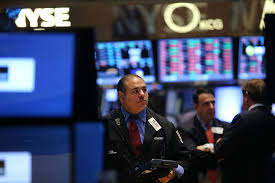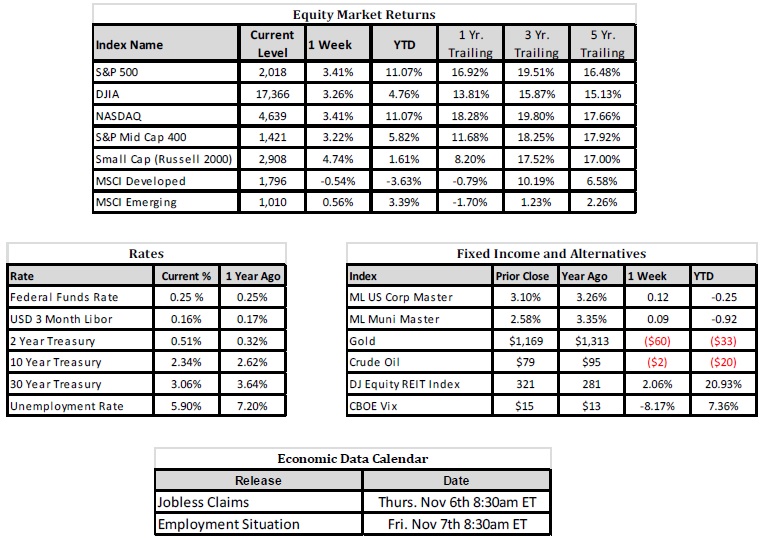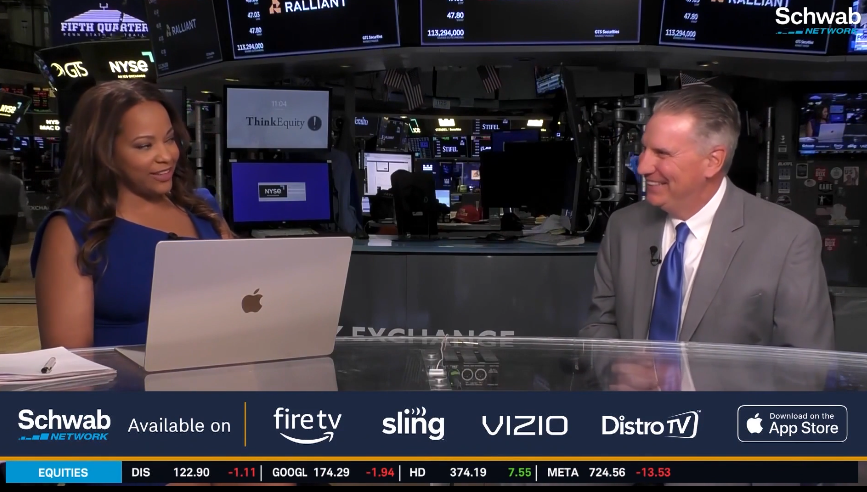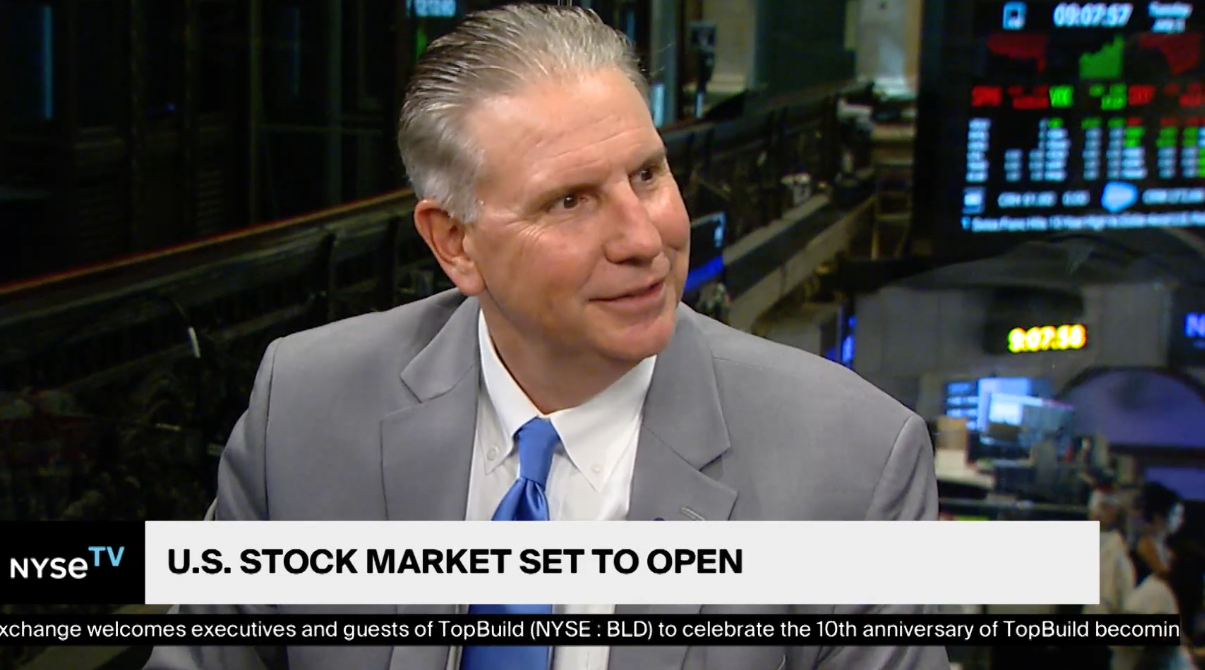
Capital Markets Update – Week of 11/3/2014
Market Overview
Sources: Rates Data and Economic Calendar—Bloomberg Markets as of 11/03/14; Equity Market Returns and Fixed Income and Alternatives Data—Wells Fargo Advisers as of 10/31/14.
Happening Now
Stock Market Pullback and Current Valuation
During 2014 there have been a lot of critics questioning the valuation of the US equity markets and a lot of news articles discussing whether investors would be smart to invest in US stocks considering the debatably stretched equity prices. The argument against investing seems to be a function of the double digit returns the S&P 500 has experienced in 4 of the past 5 years, GDP growing at a sub-par pace relative to other historical recoveries and the unprecedentedly accommodative Federal Reserve’s pace of asset purchases. While some investors seem to have been waiting for a pullback before investing with the confidence that they will be able to spot the bottom and move cash off the sideline, the moment they have been waiting for this year may have come and passed them by already.
A pullback is typically defined as a decline in price of between 5-10% and after the S&P 500 index hit an all-time high of 2011.36 on September 18, it proceeded to sell off by 7.4% and close 4 weeks later on October 15 at 1862.49. Since then, the market has come back, eclipsing the historical market high reached during September and closing on Friday, October 31 at the level of 2018.05. This represented a year to date (YTD) return of over 9%. With interest rates remaining persistently low and foreign equity growth prospects looking weak in the short term, U.S. stocks may continue to move higher.
Earnings season is also underway and so far (as of 10/31/14) 362 companies have reported with 78% beating earnings estimates and 59% exceeding on their top line numbers. The 12-month EPS estimate is currently 128.53. Thus, with a closing price of 2018.05 the 12-month forward P/E ratio of the S&P 500 index is 15.9- or 1.85% below the 20 year average for large cap stocks of 16.2. More information on earnings season from financial information provider “Fact Set” can be found here.
Investors that are apprehensive about putting new capital to work in this environment should consider asset classes that can be used as counterweights to their equity market exposure. We utilize a wide range of asset classes and sectors, such REITs and commodities, in an effort to help mitigate the overall volatility of portfolios’ returns.
Important Information and Disclaimers
Past Performance is not a guide to future performance.
Investing in foreign securities presents certain risks not associated with domestic investments, such as currency fluctuation, political and economic instability, and different accounting standards. This may result in greater share price volatility. These risks are heightened in emerging markets.
There are special risks associated with an investment in real estate, including credit risk, interest rate fluctuations and the impact of varied economic conditions. Distributions from REIT investments are taxed at the owner’s tax bracket.
The prices of small company and mid cap stocks are generally more volatile than large company stocks. They often involve higher risks because smaller companies may lack the management expertise, financial resources, product diversification and competitive strengths to endure adverse economic conditions.
Investing in commodities is not suitable for all investors. Exposure to the commodities markets may subject an investment to greater share price volatility than an investment in traditional equity or debt securities. Investments in commodities may be affected by changes in overall market movements, commodity index volatility, changes in interest rates or factors affecting a particular industry or commodity.
Products that invest in commodities may employ more complex strategies which may expose investors to additional risks.
Investing in fixed income securities involves certain risks such as market risk if sold prior to maturity and credit risk especially if investing in high yield bonds, which have lower ratings and are subject to greater volatility. All fixed income investments may be worth less than original cost upon redemption or maturity. Bond Prices fluctuate inversely to changes in interest rates. Therefore, a general rise in interest rates can result in the decline of the value of your investment.
Definitions
MSCI- EAFE: The Morgan Stanley Capital International Europe, Australasia and Far East Index, a free float-adjusted market capitalization index that is designed to measure developed-market equity performance, excluding the United States and Canada.
MSCI-Emerging Markets: The Morgan Stanley Capital International Emerging Market Index, is a free float-adjusted market capitalization index that is designed to measure the performance of global emerging markets of about 25 emerging economies.
Russell 3000: The Russell 3000 measures the performance of the 3000 largest US companies based on total market capitalization and represents about 98% of the investible US Equity market.
ML BOFA US Corp Mstr [Merill Lynch US Corporate Master]: The Merrill Lynch Corporate Master Market Index is a statistical composite tracking the performance of the entire US corporate bond market over time.
ML Muni Master [Merill Lynch US Corporate Master]: The Merrill Lynch Municipal Bond Master Index is a broad measure of the municipal fixed income market.
Investors cannot directly purchase any index.
LIBOR, London Interbank Offered Rate, is the rate of interest at which banks offer to lend money to one another in the wholesale money markets in London.
The Dow Jones Industrial Average is an unweighted index of 30 “blue-chip” industrial U.S. stocks.
The S&P Midcap 400 Index is a capitalization-weighted index measuring the performance of the mid-range sector of the U.S. stock market, and represents approximately 7% of the total market value of U.S. equities. Companies in the Index fall between S&P 500 Index and the S&P SmallCap 600 Index in size: between $1-4 billion.
DJ Equity REIT Index represents all publicly traded real estate investment trusts in the Dow Jones U.S. stock universe classified as Equity REITs according to the S&P Dow Jones Indices REIT Industry Classification Hierarchy. These companies are REITSs that primarily own and operate income-producing real estate.




